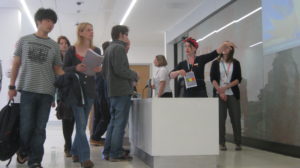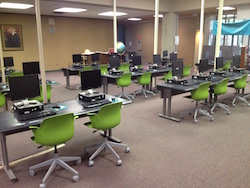
I came away from the transparency lecture and readings with a new sense of urgency. I first wanted to forward the readings pertaining to leadership to my dean (a great administrator, but not a librarian) to emphasize the importance of seeing how the front line deals with the day to day issues of an academic library.
I then veered off into thinking which of the articles I wanted to share with my library colleagues, but decided to hold off because they might take some of the articles like Turning “No” into “Yes” as me being on some high horse expounding new dictates to my peers. As the library’s department chair, I can see this move as being very preachy and overbearing.
I decided to take a deep breath and focus on two key “signposts” that I may be able to broach for discussion:
Give everyone an avenue to talk. The library has gone through multiple “facelifts” to try and make it a more modern space and sometimes we jump into projects without talking to our front line staff or our patrons. One was getting new chairs for our public computer area. We loved the color but some complained that the chairs were too hard and too colorful. For the record, we did not ask our patrons their opinion, but we did get interior design students to help with the choice.

What really hit home was the story @Michael shared about the Urbana Free Library’s weeding project. My library is conducting a large weeding project in order to free up space for more of a commons feel in one area of the library. We are weeding furiously –albeit with more parameters than Urbana’s (all books over 10 years old) — but did we actually ask our students and faculty what they thought about this weeding project? Did we post the news on our Facebook page or via Twitter feeds? No, not at all. The fact that our statistics showed a decrease in the circulation of general books gave us enough reason to attack the stacks. Now I’m feeling a little queasy about that decision. We could have taken a different approach by reaching out to more faculty (we contacted some) and posting a notice to social media. Or, do what the University of Eastern Washington did by posting a blog where students could post anonymous recommendations to the library. Brilliant!
Focus on user driven driven policy, not driving users away. The library conducted its triennial satisfaction survey just last semester. Students said wanted more collaborative space to work on digital media projects and the like. At the same time, we were seeing reference statistics decrease as well as book checkouts. So, why is our book budget still the same as it was five years ago? Let’s funnel some of that book budget money to creating a digital media lab. Ah, sounds like a great idea, but that would mean we would have to take funds from the sacred book budget! That’s where the article Turning “No” into “Yes” was very helpful giving me the idea of creating an innovation workgroup to look at all new ideas that we may want to investigate, bring back to the table and give a thorough evaluation. After all, what is the use of surveying your clientele if you are not going to listen to them?

This are two of my favorite signposts, both intended to engage with the folks we serve. The new chairs look great to me but I am partial to hues of green. Learning that the front liners and users should be involved is a good lesson. Brian Kenney at White Plains told me that put out a bunch of different chair styles and had people vote!